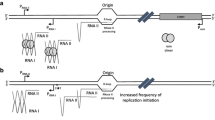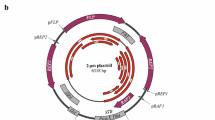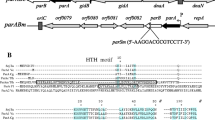Summary
The heritable stability of the multicopy plasmid ColE1 and its natural relatives, requires the presence in the plasmid of a site (cer in ColE1) that acts as a substrate for site-specific recombination, thereby maintaining plasmids in the monomeric state. Multimerization, promoted by homologous recombination, leads to plasmid loss. Here we show that the Escherichia coli chromosome encodes at least two unlinked functions that act on cer and its analogous sites, to promote stabilizing site-specific recombination. One of these functions is encoded by a gene residing on a cosmid that also contains the argI and pyrB genes, mapping it to the 96–97 min region of the E. coli map.
Similar content being viewed by others
References
Austin S, Ziese M, Sternberg N (1981) A novel role for site-specific recombination in maintenance of bacterial replicons. Cell 25:729–736
Bachmann BJ (1972) Pedigrees of some mutant strains of Escherichia coli K12. Bacteriol Res 36:525–557
Bachmann BJ (1983) Linkage map of E. coli K-12. Microbiol Rev 47:180–230
Boyko WL, Ganschow RE (1982) Rapid identification of Escherichia coli transformed by pBR322 carrying inserts at the PstI site. Anal Biochem 122:85–88
De Bruijn FJ, Lupski JR (1984) The use of transposon Tn5 mutagenesis in the rapid generation of correlated physical and genetic maps of DNA segments cloned into multicopy plasmids — a review. Gene 27:131–149
Dodd HM, Bennett PM (1986) Location of the site-specific recombination system of R46: a function necessary for plasmid maintenance. J Gen Microbiol 132:1009–1020
Gennaro ML, Kornblum J, Novick RP (1987) A site-specific recombination function in Staphylococcus aureus plasmids. J Bacteriol 169:2601–2610
Greene PI, Gupta M, Boyer HW, Brown WE, Rosenberg JM (1981) Sequence analysis of the DNA encoding the EcoRI endonuclease and methylase. J Biol Chem 256:2143–2153
Hakkaart MJJ, Van den Elzen PJM, Veltkamp E, Nikjamp HJJ (1984) Maintenance of multicopy plasmid CloDF13 in E. coli cells: evidence for site-specific recombination of parB. Cell 36:203–209
Kohara Y, Akiyama K, Isono K (1987) The physical map of the whole E. coli chromosome: Application of a new strategy for rapid analysis and sorting of a large genomic library. Cell 50:495–508
Lane D, de Feyter R, Kennedy M, Phua S-H, Semon D (1986) D protein of miniF acts as a repressor of transcription and as a site-specific resolvase. Nucleic Acids Res 14:9713–9728
Leung DW, Chen E, Cachianes G, Goeddel DV (1985) Nucleotide sequence of the partition function of E. coli plasmid ColE1. DNA 41:351–355
Maniatis T, Fritsch EF, Sambrook J (1982) Molecular cloning: a laboratory manual. Cold Spring Harbor Laboratory Press, Cold Spring Harbor, New York
Morlon J, Chartier M, Bidaud M, Lazdunski C (1988) The complete nucleotide sequence of the colicinogenic plasmid ColA. High extent of homology with ColE1. Mol Gen Genet 211:231–243
Sadowski P (1986) Site-specific recombinases: changing partners and doing the twist. J Bacteriol 165:341–347
Sherratt D, Dyson P, Boocock M, Brown L, Summers D, Stewart G, Chan P (1984) Site-specific recombination in transposition and plasmid stability. Cold Spring Harbor Symp Quant Biol 49:227–233
Summers DK, Sherratt DJ (1984) Multimerization of high copy number plasmids causes instability: ColE1 encodes a determinant essential for plasmid monomerization and stability. Cell 36:1097–1103
Summers DK, Sherratt DJ (1988) Resolution of ColE1 dimers requires a DNA sequence implicated in the three-dimensional organization of the cer site. EMBO J 7:851–858
Summers DK, Yaish S, Archer J, Sherratt DJ (1985) Multimer resolution systems of ColE1 and ColK: localization of the crossover site. Mol Gen Genet 201:334–338
Thompson JF, Moitoso de Vargas L, Koch C, Kahmann R, Landy A (1987) Cellular factors couple recombination with growth phase: characterization of a new component in the λ site-specific recombination pathway. Cell 50:901–908
Vieira J, Messing J (1982) The pUC plasmids, an M13mp7-derived system for insertion mutagenesis and sequencing with synthetic universal primers. Gene 19:259–268
Volkert FC, Broach JR (1986) Site-specific recombination promotes plasmid amplification in yeast. Cell 46:541–550
Author information
Authors and Affiliations
Additional information
Communicated by W. Goebel
Rights and permissions
About this article
Cite this article
Stirling, C.J., Stewart, G. & Sherratt, D.J. Multicopy plasmid stability in Escherichia coli requires host-encoded functions that lead to plasmid site-specific recombination. Mol Gen Genet 214, 80–84 (1988). https://doi.org/10.1007/BF00340183
Received:
Issue Date:
DOI: https://doi.org/10.1007/BF00340183




